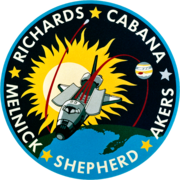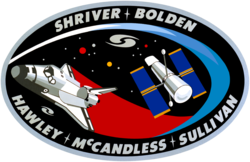STS-41
| STS-41 | |||||
 | |||||
| Uppdrag | 36 | ||||
|---|---|---|---|---|---|
| Rymdfärja | Discovery (11)[1] | ||||
| NSSDC-ID | 1990-090A[2] | ||||
| Färdens tid | 4 dagar, 2 timmar, 10 minuter, 4 sekunder | ||||
| Uppskjutning | |||||
| Startplats | Startplatta 39B vid Kennedy Space Center i Florida | ||||
| Start | 6 oktober 1990, 7:47:15 a.m. EDT | ||||
| Landning | |||||
| Landningsplats | Runway 22, Edwards Air Force Base, Calif. | ||||
| Landning | 10 oktober 1990, 6:57:18 a.m. PDT | ||||
| Omloppsbana | |||||
| Varv | 65 st[3] | ||||
| Apogeum | 307 km | ||||
| Perigeum | 300 km | ||||
| Banlutning | 28,45° | ||||
| Sträcka | 2,748 miljoner km | ||||
| Besättning | |||||
| Befälhavare | Richard N. Richards (2) | ||||
| Pilot | Robert D. Cabana (1) | ||||
| Uppdragsspecialister | William M. Shepherd (2) Bruce E. Melnick (1) Thomas D. Akers (1) | ||||
 | |||||
| Kronologi Rymdfärjeprogrammet | |||||
| |||||
STS-41 var den trettiosjätte flygningen i det amerikanska rymdfärjeprogrammet och elfte i ordningen för rymdfärjan Discovery. Den sköts upp från Pad 39B vid Kennedy Space Center i Florida den 6 oktober 1990. Efter drygt fyra dagar i omloppsbana runt jorden återinträdde rymdfärjan i jordens atmosfär och landade vid Edwards Air Force Base i Kalifornien.
Uppdragets mål
Huvudsaklig målet var att placera ut rymdsonden Ulysses som skulle sändas ut i vidare bana i solsystemet där den skulle åka ovan solens båda poler.
Uppdragets besättning
- Richard N. Richards, befälhavare (2)
- Robert D. Cabana, pilot (1)
- William M. Shepherd, uppdragsspecialist (2)
- Thomas D. Akers, uppdragsspecialist (1)
- Bruce E. Melnick, uppdragsspecialist (1)
Väckningar
Under Geminiprogrammet började NASA spela musik för besättningar och sedan Apollo 15 har man varje "morgon" väckt besättningen med ett särskilt musikstycke, särskilt utvalt antingen för en enskild astronaut eller för de förhållanden som råder.
| Dag | Låt | Artist/Kompositör | Spelad för |
|---|---|---|---|
| 2 | Rise and Shine, Discovery! | anställda hos Boeing | Ulysses |
| 3 | Semper Paratus | The Coast Guard Band | Bruce Melnick |
| 4 | Fanfare for the Common Man | Aaron Copland | |
| 5 | The Highwayman | The Highwaymen |
Se även
Referenser
- ^ NASA Space Shuttle Launch Archive Arkiverad 28 juli 2012 hämtat från the Wayback Machine., läst 28 juli 2016.
- ^ ”NASA Space Science Data Coordinated Archive” (på engelska). NASA. https://nssdc.gsfc.nasa.gov/nmc/spacecraft/display.action?id=1990-090A. Läst 18 mars 2020.
- ^ Manned Astronautics - Figures & Facts Arkiverad 16 augusti 2016 hämtat från the Wayback Machine., läst 28 juli 2016.
Externa länkar
 Wikimedia Commons har media som rör STS-41.
Wikimedia Commons har media som rör STS-41.
| ||||||||
| ||||||||||||||||||||||||||||||||
Media som används på denna webbplats
Författare/Upphovsman: Pascal (Flickr user: pasukaru76), Licens: CC0
Vostok spacecraft replica at the Technik Museum Speyer, Germany.
STS-41 Mission Insignia
The 5 member crew of the STS-41 mission included (left to right): Bruce E. Melnick, mission specialist 2; Robert D. Cabana, pilot; Thomas D. Akers, mission specialist 3; Richard N. Richards, commander; and William M. Shepherd, mission specialist 1. Launched aboard the Space Shuttle Discovery on October 6, 1990 at 7:47:15 am (EDT), the primary payload for the mission was the ESA built Ulysses Space Craft made to explore the polar regions of the Sun. Other main payloads and experiments included the Shuttle Solar Backscatter Ultraviolet (SSBUV) experiment and the INTELSAT Solar Array Coupon (ISAC).
STS-38 Mission Insignia
STS-31 shuttle mission flight insignia. The mission insignia for NASA's STS-31 mission features the Hubble Space Telescope (HST) in its observing configuration against a background of the universe it will study. The cosmos includes a stylistic depiction of galaxies in recognition of the contribution made by Sir Edwin Hubble to our understanding of the nature of galaxies and the expansion of the universe. The STS-31 crew points out that is it in honor of Hubble's work that this great observatory in space bears his name. The depicted Space Shuttle trails a spectrum symbolic of both the red shift observations that were so important to Hubble's work and new information which will be obtained with the HST. Encircling the art work, designed by the crew, are the names of its members.






